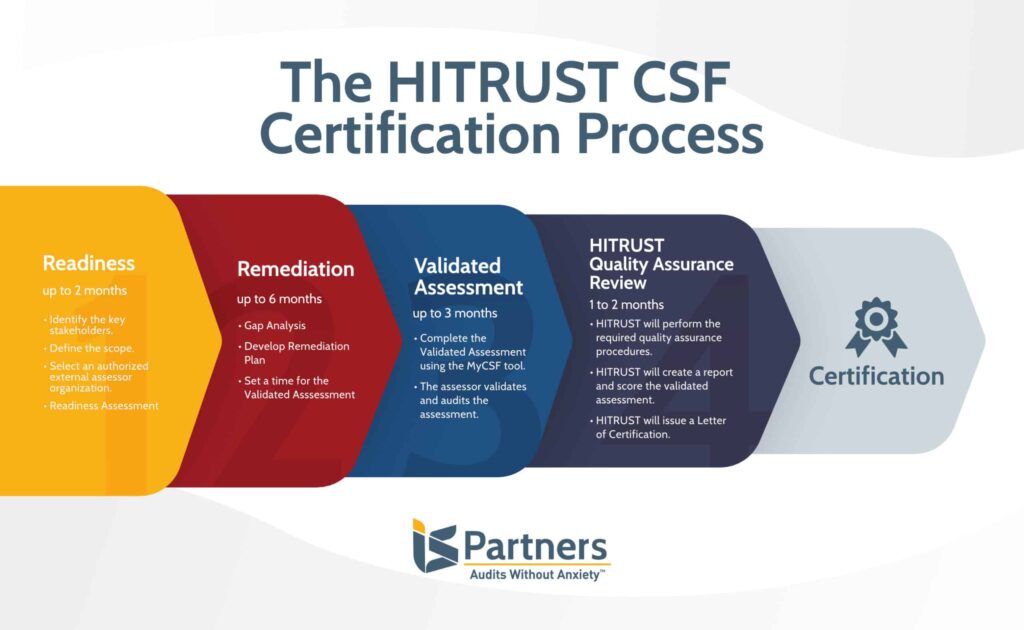Key Takeaways
1. The HITRUST Certification refers to a program that verifies the compliance of an organization with the requirements and regulations set by HITRUST.
2. The HITRUST Certification process involves 4 main steps: 1) readiness, 2) remediation, 3) validated assessment, and 4) HITRUST review.
3. IS Partners is a trusted auditing firm that can help you navigate through the comprehensive requirements of the HITRUST CSF.
What Is HITRUST Certification?
The Health Information Trust Alliance (HITRUST) Certification is a program that verifies a service organization’s holistic control over sensitive data and compliance with data security standards. The certification means an organization has partnered with an authorized HITRUST External Assessor to pass a comprehensive security evaluation.
Achieving the HITRUST Certification helps set your organization apart from others in the industry. It affirms that industry leaders prioritize security and consumer transparency. It also shows that the organization has met all industry regulations while maintaining high standards of leading security practices on data loss prevention and information risk management.
The process is detailed, time-consuming, and intense, but it will ultimately set your organization up for success. That’s why it’s considered the gold standard for compliance in the healthcare industry and a wide range of industries with regulatory compliance standards.
The HITRUST Certification Process in 4 Steps
When getting started, the key is solid preparation. Most organizations seek assistance from an Authorized HITRUST External Assessor or certification partner, who helps determine the scope, type of assessment needed, and controls to address.
Below, we summarize the detailed HITRUST Certification process into 4 easy steps.

This process has four main phases: readiness, remediation, validated assessment, and the HITRUST Quality Assurance review. The culmination of the HITRUST assessment process is certification.
1. Readiness
The readiness step starts with a readiness assessment, which includes defining the scope of the certification and selecting a trusted assessor.
Defining the scope of HITRUST assessments is a key preparatory step. It defines which business units and subsidiaries are affected, as well as what is covered by controls. If the scope isn’t properly outlined, there will likely be too many or too few requirements to reach certification.
Once the scope is determined, the partner will examine and measure all documentation of policies and procedures against current HITRUST requirements and controls. During this time, the assessor will test controls to validate whether they are working as listed.
This step aims to identify potential gaps and vulnerabilities stemming from non-compliance. Documentation is a critical step for the certification readiness phase. All gaps will be documented for remediation.
IS Partners expert identifies this step as the key to an efficient assessment,
“The most critical part of the certification process is scoping the implemented system. To successfully complete a HITRUST assessment, the implemented system must be correctly scoped. Proper scoping ensures that all relevant systems, processes, and data flows are included in the assessment. This enables a thorough risk assessment, identifying all potential vulnerabilities and threats.
Without accurate scoping, critical areas might be overlooked, leading to an incomplete risk profile and potentially leaving the assessed organization exposed to security risks. In addition, Defining the scope precisely helps in allocating resources effectively. It prevents the waste of time and effort on irrelevant systems or controls that do not impact the organization’s compliance status.
This efficiency is crucial in streamlining the certification process and focusing efforts where they are most needed.”
Kevin Patterson, Manager of Healthcare Compliance, IS Partners
This can take up to 8 weeks, depending on the size and complexity of the organization’s infrastructure.
2. Remediation
The organization will address all performance or documentation gaps found during the readiness phase. The goal of this phase is to identify and rank gaps in your organization by risk level. This provides the organization with opportunities for remediation before moving forward to the validated assessment.
During the remediation phase, authorized assessors should work to understand the organization’s environment and the normal flow of data through systems within the scope. They analyze requirements to understand the organization’s controls, identify gaps, and find workable solutions to remediate any gaps found.
Then, as the company works to remediate issues, assessors can provide ongoing support and review progress toward HITRUST compliance.
This process can take up to 6 months, the first year, depending on the type of remedial actions required by the organization. The more non-compliance and risk management gaps found, the longer the remediation process will take.
3. Validated Assessment
During the validated assessment, the assessor tests the defined control requirements of each designated category. An on-site risk HITRUST assessment usually includes interviews with key personnel, reviewing supporting documents, sampling, penetration testing, and vulnerability scans.
Each requirement is evaluated or scored based on the following attributes for control maturity strength:
- Policy,
- Process/Procedure,
- Implementation,
- Measured, and
- Managed.
Based on these control maturity levels, the levels of compliance are evaluated as any of the following statuses:
- Fully compliant,
- Mostly compliant,
- Partially compliant,
- Somewhat compliant, and
- Non-compliant.
During this HITRUST-validated assessment testing phase, authorized assessors review and validate the organization’s scores. Then, they send the final assessment to HITRUST for approval. HITRUST makes the final decision about approving or denying the application for certification.
4. HITRUST’s Quality Assurance Review & Report Generation
Once the validated assessment is complete, it is submitted to HITRUST for quality assurance review and the generation of the final report. HITRUST’s submission processing typically ranges from 4 to 8 weeks.
Learn more about how to prepare for a HITRUST CSF certification process here.
HITRUST Certification Requirements
Understanding the main HITRUST CSF certification requirements fully and implementing them can streamline the auditing process. Organizations can seek the help of a recognized auditing firm to identify which control requirements apply to the company.
The HITRUST CSF program typically consists of 19 control domain requirements.
- Information security program
- Endpoint protection
- Portable media security
- Mobile device security
- Wireless security
- Configuration management
- Vulnerability management
- Network protection
- Transmission protection
- Password management
- Access control
- Audit logging and monitoring
- Education, training, and awareness
- Third-party assurance
- Incident management
- Business continuity and disaster recovery
- Information Risk Management Program
- Physical and environmental security
- Data protection and privacy
Organizations must meet a minimum baseline score across all the assessed controls to achieve certification, typically a 3+ rating on HITRUST’s 1-5 scale. The diversity of applicable controls in an organization critically affects the length and cost of HITRUST certification.
Over the years, these requirements have evolved to adapt to the growing complexity of the cybersecurity landscape. Robert Godard, one of the Partners at IS Partners, highlighted the key developments regarding the HITRUST requirements and certification process,
“When thinking of the evolution of the HITRUST Certification process, two core areas come to mind. The first is the assessment process, and the second is the risk landscape, which is affected by changing technology, regulations, and security threats.
HITRUST has worked to streamline the assessment process, making it more efficient for organizations seeking certification. This includes scheduling for QA, providing alternate certification paths for organizations with the e1 and i1 assessments, and providing resources such as standardized tools and templates.
Additionally, HITRUST has greatly expanded the guidance section within the portal to help organizations prepare for assessments. Specifically, the assessment handbook has provided comprehensive instructions that make the assessment process clearer for both the assessed entity and the assessor.”
Robert Godard, Senior Partner, IS Partners
Integrate IS Partners’ auditing services into your journey toward HITRUST compliance. Our expert HITRUST-accredited auditors can help you identify all applicable controls and determine the extent and scope of your certification requirements.
Streamline your pursuit for a HITRUST Certification with the help of IS Partners.
How Long Does It Take to Get HITRUST Certified?
This depends mostly on your organization’s preparedness and the skilled guidance your assessor provides. If this is the first time that your organization is working towards HITRUST certification, the process may take up to 12 months to complete successfully.
Each certification phase must be fully accomplished before moving to the next. Below are estimations of how long each HITRUST certification phase could take:
- Phase 1 (Readiness): 2 months
- Phase 2 (Remediation): 6 months
- Phase 3 (Validated Assessment): 3 months
- Phase 4 (QA Review): 1 to 2 months
Some key factors that impact the certification timeline include:
- The organization’s size and complexity
- Maturity of existing security controls and processes
- Available resources to implement HITRUST requirements
- Management commitment to drive the certification process
Organizations can streamline their path to certification by working with experienced HITRUST assessors, scoping their assessments effectively, and leveraging inheritable controls from cloud service providers.
How Long Is HITRUST Certification Valid For?
The HITRUST certification is valid for 24 months, with an interim review required to ensure standards continue being met. After 12 months, interim assessment testing is required. This is designed to ensure the ongoing effectiveness of data security controls for organizations that have already received certification. Interim testing also serves to update the scope and scores as needed.
After two years, the certification expires, and the organization must undergo recertification. However, the HITRUST Bridge Assessment can help organizations maintain their HITRUST certification report for an additional 90 days while working to complete re-certification.
What Are the Benefits Of HITRUST Certification?
One of the many benefits of HITRUST certification is it adds credibility and visibility to an organization. It also improves its information security outlook by identifying potential security risks in the privacy and data protection infrastructure.
HITRUST certification maps out a path towards complying with other essential regulatory standards. It reduces the time investment and costs of complying with GDPR, PCI, and HIPAA compliance standards.
With certification, organizations can circumvent potential issues if a secondary audit is needed. The HITRUST certification demonstrates the effectiveness of an organization’s security protocols for consumers and other businesses.
Who Needs HITRUST Certification?
HITRUST Certification is ideal for companies that create, access, store, and exchange sensitive information. This includes
- healthcare organizations,
- vendors,
- hospitals,
- pharmacies,
- health insurance firms, and
- medical offices.
The program is globally recognized and implemented by companies of all sizes. Other global organizations outside of healthcare, such as Marriott, Google, Amazon, Microsoft, Sony, and more, have also successfully obtained the HITRUST certification.
The HITRUST framework was designed to ensure that healthcare-related facilities subject to HIPAA and their third-party business associates meet security regulations. Because HITRUST is a comprehensive combination of multiple security and privacy standards—including HIPAA, HITECH, PCI, COBIT, and NIST—it has become widely applicable in other industries as well.
Now, the HITRUST framework can streamline risk management operations. It is being effectively used by companies in the insurance, government, biotech, life sciences, technology, and financial sectors, to name a few.

Get Professional Assistance With HITRUST Certification From IS Partners
The certification process is rigorous, but it’s well worth the effort. Your organization will achieve the highest standards of compliance, which will be recognized throughout the industry.
Collaborating with the right technical audit team is key. IS Partners, LLC works with organizations to obtain certification and make the entire experience stress-free. With our help, you can optimize the entire certification process and get certified fast.
Your company will be overseen by an expert on HITRUST CSF Certification and guided to achieve faster solutions.
Find out more about how we can assist you in becoming HITRUST certified. Contact our team at 215-675-1400 or contact us online to discuss how we can help your organization.










